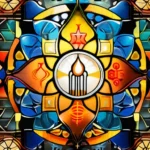Explore the key branches and beliefs within Islam, from Sunni to Shia and beyond.
Islam is one of the world’s major religions, with a diverse range of sects and beliefs. In this article, we delve into the major sects of Islam, providing you with an in-depth understanding of their unique practices, history, and significance.
The History and Origins of Islam
Imagine a vast ocean, where every drop represents a unique strand of belief within Islam. At its heart lies the story of Muhammad, a man who would become not just a prophet but also the founder of one of the world’s largest religions—Islam. Who was this man that sparked such a profound change in history?
The journey begins around 610 CE when Muhammad had his first divine revelation in a cave on Mount Hira, near Mecca. This event marked the start of what would become the Qu’ran, the holy book of Islam. Was it destiny or divine intervention that led him to this moment?
The early days were tough as Muhammad faced opposition and persecution from some in his own community. But he persevered, spreading his message of monotheism and justice. His first followers formed a small community that gradually grew larger, overcoming numerous challenges. How did such a tiny flame manage to ignite the world?
The split between Sunni and Shia occurred shortly after Muhammad’s death in 632 CE over questions of leadership. The Sunnis believe in choosing leaders from among the Prophet’s companions, while Shias believe that leadership should have gone to Ali, who was Muhammad’s cousin and son-in-law. This division set the stage for a complex landscape within Islam, with each sect carrying its own rich tapestry of beliefs and practices.
Understanding the origins of Islam is crucial because it helps us grasp why certain traditions exist today. It’s like tracing the roots of a tree to understand its current shape—without knowing where it came from, it’s hard to fully appreciate its beauty and significance.
The Sunni Branch: The Largest Sect in Islam
The Sunni branch, often referred to as Ahl al-Sunnah wa Al-Jamāʿah, forms the largest sect within Islam and holds a dominant position in the global Muslim population. But what exactly defines this vast community?
Imagine the vast desert expanses of Arabia; the Sunni Muslims are like the endless sands that cover much of the Islamic world. They believe in the Sunnah, or the practices and sayings attributed to the Prophet Muhammad, emphasizing his teachings as a guide for living. This branch upholds the first four caliphs—Abu Bakr, Umar, Uthman, and Ali—as rightful leaders after the Prophet’s death.
But how did this belief system come into being? The division between Sunni and Shia stems from a significant event: who would succeed Muhammad as the leader of the Muslim community. Sunnis believe that Abu Bakr was chosen through consensus, while Shias believe Ali should have been the first caliph due to his close relationship with the Prophet. This historical rift has shaped the practices and beliefs of both sects over centuries.
Practically speaking, Sunnis follow a variety of schools of thought or madhabs such as Hanafi, Maliki, Shafii, and Hanbali. These schools provide guidance on issues ranging from religious rituals to personal ethics. The diversity within Sunni Islam is vast, reflecting the broad spectrum of interpretations and practices among its followers.
However, despite this variety, certain core beliefs unite Sunnis: the oneness of God (Tawhid), the prophethood of Muhammad, and the acceptance of the Quran as the final revealed word. These foundational tenets are like the bedrock that holds the Sunni community together, providing a common framework for worship and moral conduct.
Understanding the Sunni branch is crucial not only because it comprises the majority of Muslims but also because its influence spans across cultures and continents. As we delve deeper into the Shia branch in the following section, remember that while the paths diverge, both sects share the core values rooted in the teachings of Islam.
How do you think this vast community shapes Islamic practices worldwide?
The Shia Branch: A Distinctive Path
The Shia branch of Islam emerged from a pivotal moment that changed the course of Islamic history: the dispute over who would succeed the Prophet Muhammad. Imagine a small flame in the dark, flickering and then suddenly growing into a massive lantern—this is how the Shia movement began. The Shia believe that Ali, the cousin and son-in-law of the Prophet, should have been the first caliph after his death, rather than Abu Bakr. This disagreement sparked a profound split within the Muslim community.
Think of it like choosing sides in a game: you’re either with the Imams, who are considered divinely appointed leaders by Shias, or not. The Imams play a central role in Shia belief, often seen as the direct descendants of Ali and Fatima, the daughter of the Prophet. They are viewed as infallible guides, possessing both religious and political authority.
The rituals and practices of Shias reflect their deep connection to these leaders. Many engage in taqlid, following the teachings of specific Imams. During important festivals like Ashura, they commemorate the martyrdom of Imam Hussein, Ali’s grandson, through emotional processions and fasting. These customs are a testament to the profound impact of historical events on their faith.
While the Sunni-Shia divide can sometimes appear as a simple battle over power or authority, it runs much deeper. It’s about values, spirituality, and the role of leadership in religious life. Understanding this branch helps us see how Islamic history is not just a series of political battles but a rich tapestry of beliefs that continue to shape millions of lives today.
Sufism: The Mystical Path within Islam
Imagine Islam as a vast ocean, with various currents and eddies that reflect its rich diversity. One such current is Sufism, often referred to as the mystical branch within Islam. While Sunni and Shia sects focus on the outward practices and historical disputes, Sufism delves into the heart of spirituality, seeking a direct experience with God.
In many ways, Sufism is like a lighthouse in the dark sea of life. It guides souls towards divine love and unity through poetry, music, dance, and meditation. The term ‘Sufi’ comes from the Persian word sūf, meaning wool, symbolizing the simple, humble garments worn by early Sufis as a sign of their renunciation of worldly life.
One of the core principles in Sufism is the idea that every individual has a direct path to God, bypassing intermediaries. This can be compared to finding a shortcut through a dense forest rather than following the main trail. For Sufis, the journey towards God involves purifying one’s heart and soul, transcending the material world to reach a state of walāyah, or divine proximity.
Sufi orders, known as tarikats, play a crucial role in guiding practitioners on their spiritual path. Each tarikat has its own unique methods and practices, but they all share the common goal of drawing closer to God through submission and devotion. These orders often act like a map, showing you where to find the hidden treasures within yourself.
But why explore Sufism? Isn’t it just another branch? The truth is, every part of this ocean is interconnected, and understanding Sufism enriches our overall knowledge of Islam. It’s a journey that can inspire us all, reminding us that the essence of faith lies in its innermost depths, where love for God reigns supreme.
Other Major Sects of Islam: Ahmadiyya, Ibadi, and More
When delving into the rich tapestry of Islamic sects, it becomes clear that there are far more nuances and variations than just the commonly known Sunni and Shia branches. One such branch is the Ahmadiyya, which has its own unique beliefs and practices.
Are we familiar enough with the Ahmadiyya movement? This sect emerged in the late 19th century, claiming a spiritual lineage that extends beyond the traditional prophetic line of Islam. Founded by Mirza Ghulam Ahmad, who followers believe is the promised Messiah and Mahdi, Ahmadiyya offers a distinct perspective on Islamic theology.
Their interpretation of the Quran and Hadith differs from mainstream Sunni teachings, emphasizing peace, tolerance, and interfaith dialogue. This has often placed them in a complex position within the broader Muslim community, where they are sometimes considered heretical by some Sunni scholars due to their beliefs about Mirza Ghulam Ahmad.
Meanwhile, Ibadi is another significant sect that has its roots in early Islamic history. Unlike Ahmadiyya, Ibadi Islam maintains a strong presence in certain regions, particularly Oman and parts of North Africa. Their belief system places less emphasis on the Sunni-Shia divide, focusing instead on governance based on justice and the rule of law.
How do these sects coexist with mainstream Sunni and Shia Muslims? The answer is not always harmonious; Ibadi communities often have a distinct identity that sets them apart from other Muslim groups. Their approach to religious practice and governance can lead to both acceptance and conflict in diverse Islamic societies.
In addition, there are numerous smaller sects within Islam such as the Ismaili community, which is led by the Aga Khan. These communities have their unique spiritual leaders and follow a specific line of Ismaili Imams who guide them spiritually and socially.
How do these diverse sects shape the landscape of contemporary Islam? Each brings its own insights and interpretations, enriching the global Muslim community with a wide array of perspectives. While the Sunni-Shia divide remains central to many discussions about Islamic politics and theology, understanding the nuances of other major sects like Ahmadiyya, Ibadi, and Ismaili provides a more comprehensive view.
The Role of Sects in Modern Islam
As we delve into understanding the major sects of Islam, it’s crucial to explore how these various branches interact and shape modern Islamic communities. Have you ever wondered how Sunni and Shia Muslims navigate their differences in a world where religion often becomes intertwined with politics? The role of sectarian divisions has never been more pronounced than today, especially as they impact the global stage.
The interactions between different sects can be complex, much like the intricate layers of a cake. Sunni Muslims, representing over 85% of the world’s Muslim population, often find themselves in dialogue with Shia Muslims, who make up around 15%. The rivalry and cooperation between these two groups are evident not only within their communities but also in international relations.
For instance, consider how sectarian conflicts have escalated tensions in countries like Iraq and Syria. Here, the Sunni-Shia divide has become a proxy battle for larger geopolitical interests, drawing in regional powers such as Iran and Saudi Arabia. How do these external actors use religion to gain influence? It’s a question that echoes through the halls of power, often overshadowing the peaceful coexistence sought by ordinary believers.
Other sects like the Ibadi, while smaller, play significant roles in certain regions such as Oman and Zanzibar. Their unique beliefs about leadership within Islam set them apart from mainstream Sunni and Shia schools of thought. How do they contribute to the mosaic of Islamic diversity? This question invites us to explore the rich tapestry of Islamic practices that exist beyond the dominant narratives.
Understanding these sects is not just academic; it’s essential for fostering interfaith dialogue and promoting peace in a world where religious identities can be both a source of unity and division. As we continue our exploration, consider how each sect’s history, beliefs, and practices shape its relationship with the broader Muslim community and the global landscape.
Conclusion
 By gaining knowledge about the various sects of Islam, you’ll develop a deeper appreciation for the richness and diversity within this religion. Use this newfound understanding to foster greater tolerance and mutual respect among followers of different Islamic traditions.
By gaining knowledge about the various sects of Islam, you’ll develop a deeper appreciation for the richness and diversity within this religion. Use this newfound understanding to foster greater tolerance and mutual respect among followers of different Islamic traditions.











